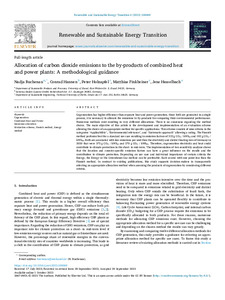| dc.date.accessioned | 2023-11-16T16:24:11Z | |
| dc.date.available | 2023-11-16T16:24:11Z | |
| dc.date.issued | 2023-10-07 | |
| dc.identifier | doi:10.17170/kobra-202311088985 | |
| dc.identifier.uri | http://hdl.handle.net/123456789/15187 | |
| dc.description.sponsorship | Gefördert durch den Publikationsfonds der Universität Kassel | ger |
| dc.language.iso | eng | |
| dc.rights | Namensnennung 4.0 International | * |
| dc.rights.uri | http://creativecommons.org/licenses/by/4.0/ | * |
| dc.subject | Cogeneration | eng |
| dc.subject | Combined Heat and Power | eng |
| dc.subject | Emissions allocation | eng |
| dc.subject | Evaluation scheme | eng |
| dc.subject | Finnish method | eng |
| dc.subject | Energy method | eng |
| dc.subject.ddc | 333 | |
| dc.title | Allocation of carbon dioxide emissions to the by-products of combined heat and power plants: A methodological guidance | eng |
| dc.type | Aufsatz | |
| dcterms.abstract | Cogeneration has higher efficiency than separate heat and power generation. Since both are generated in a single process, it is necessary to allocate the emissions to by-products for comparing their environmental performance. Numerous methods exist resulting in very different allocations. There is no consensus regarding the method choice. The main objective of this article is the development and implementation of an evaluation scheme allowing the choice of an appropriate method for specific applications. This scheme consists of nine criteria in the categories “Applicability”, “Environmental relevance”, and “Systematic approach” allowing a rating. The Finnish method performs best for a standard use case resulting in emission factors of 322 g CO₂ / kWhel and 192 g CO₂ / kWhth. Both are associated with less emissions per unit then the electricity and district heating mix of Germany in 2020 that were 375 g CO₂ / kWhel and 270 g CO₂ / kWhth. Therefore, cogeneration electricity and heat could contribute to climate protection in the short- to mid-term. The implementation of two sensitivity analyses shows that the location and country-specific emission factors can have a great influence on the results and the contribution to climate protection. Depending on use case and individual importance of certain criteria the Energy, the Exergy or the Greenhouse Gas method can be preferable. Each scored with one point less than the Finnish method. In contrast to existing publications, this study supports decision-makers in transparently selecting an appropriate allocation method when assessing the products of cogeneration by considering different criteria. | eng |
| dcterms.accessRights | open access | |
| dcterms.creator | Buchenau, Nadja | |
| dcterms.creator | Hannen, Conrad | |
| dcterms.creator | Holzapfel, Peter | |
| dcterms.creator | Finkbeiner, Matthias | |
| dcterms.creator | Hesselbach, Jens | |
| dc.relation.doi | doi:10.1016/j.rset.2023.100069 | |
| dc.subject.swd | Kraft-Wärme-Kopplung | ger |
| dc.subject.swd | Emission | ger |
| dc.subject.swd | Kohlendioxid | ger |
| dc.type.version | publishedVersion | |
| dcterms.source.identifier | eissn:2667-095X | |
| dcterms.source.journal | Renewable and Sustainable Energy Transition | eng |
| dcterms.source.volume | Volume 4 | |
| kup.iskup | false | |
| dcterms.source.articlenumber | 100069 | |


